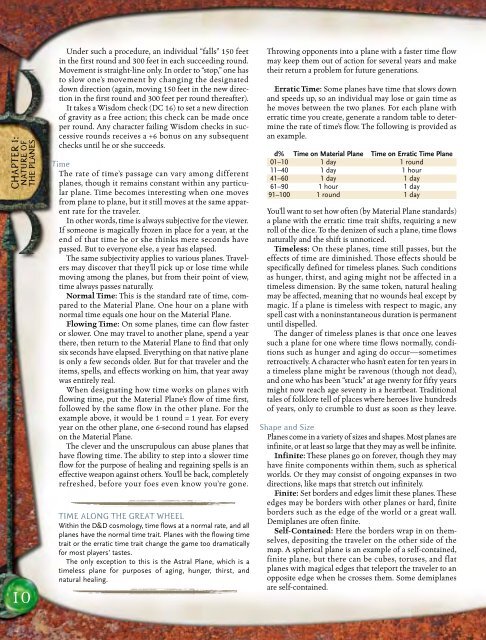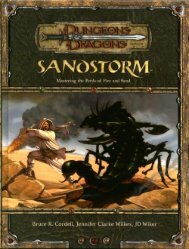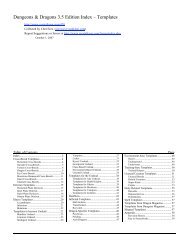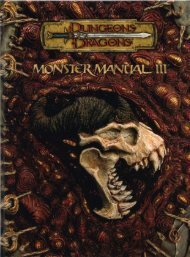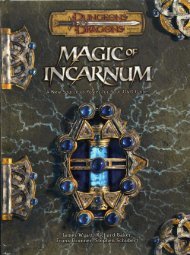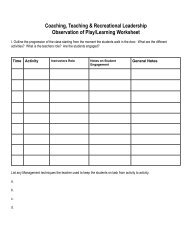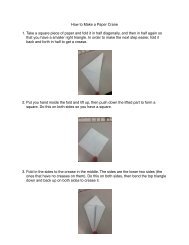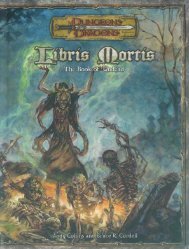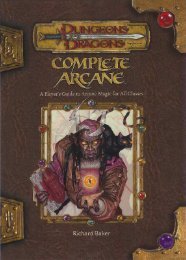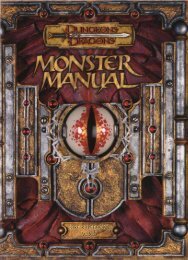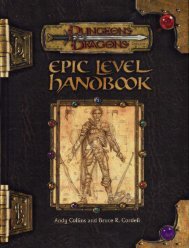Manual of the Planes
Manual of the Planes
Manual of the Planes
- No tags were found...
Create successful ePaper yourself
Turn your PDF publications into a flip-book with our unique Google optimized e-Paper software.
CHAPTER 1:NATURE OFTHE PLANES10Under such a procedure, an individual “falls” 150 feetin <strong>the</strong> first round and 300 feet in each succeeding round.Movement is straight-line only. In order to “stop,” one hasto slow one’s movement by changing <strong>the</strong> designateddown direction (again, moving 150 feet in <strong>the</strong> new directionin <strong>the</strong> first round and 300 feet per round <strong>the</strong>reafter).It takes a Wisdom check (DC 16) to set a new direction<strong>of</strong> gravity as a free action; this check can be made onceper round. Any character failing Wisdom checks in successiverounds receives a +6 bonus on any subsequentchecks until he or she succeeds.TimeThe rate <strong>of</strong> time’s passage can vary among differentplanes, though it remains constant within any particularplane. Time becomes interesting when one movesfrom plane to plane, but it still moves at <strong>the</strong> same apparentrate for <strong>the</strong> traveler.In o<strong>the</strong>r words, time is always subjective for <strong>the</strong> viewer.If someone is magically frozen in place for a year, at <strong>the</strong>end <strong>of</strong> that time he or she thinks mere seconds havepassed. But to everyone else, a year has elapsed.The same subjectivity applies to various planes. Travelersmay discover that <strong>the</strong>y’ll pick up or lose time whilemoving among <strong>the</strong> planes, but from <strong>the</strong>ir point <strong>of</strong> view,time always passes naturally.Normal Time: This is <strong>the</strong> standard rate <strong>of</strong> time, comparedto <strong>the</strong> Material Plane. One hour on a plane withnormal time equals one hour on <strong>the</strong> Material Plane.Flowing Time: On some planes, time can flow fasteror slower. One may travel to ano<strong>the</strong>r plane, spend a year<strong>the</strong>re, <strong>the</strong>n return to <strong>the</strong> Material Plane to find that onlysix seconds have elapsed. Everything on that native planeis only a few seconds older. But for that traveler and <strong>the</strong>items, spells, and effects working on him, that year awaywas entirely real.When designating how time works on planes withflowing time, put <strong>the</strong> Material Plane’s flow <strong>of</strong> time first,followed by <strong>the</strong> same flow in <strong>the</strong> o<strong>the</strong>r plane. For <strong>the</strong>example above, it would be 1 round = 1 year. For everyyear on <strong>the</strong> o<strong>the</strong>r plane, one 6-second round has elapsedon <strong>the</strong> Material Plane.The clever and <strong>the</strong> unscrupulous can abuse planes thathave flowing time. The ability to step into a slower timeflow for <strong>the</strong> purpose <strong>of</strong> healing and regaining spells is aneffective weapon against o<strong>the</strong>rs. You’ll be back, completelyrefreshed, before your foes even know you’re gone.pqsTIME ALONG THE GREAT WHEELWithin <strong>the</strong> D&D cosmology, time flows at a normal rate, and allplanes have <strong>the</strong> normal time trait. <strong>Planes</strong> with <strong>the</strong> flowing timetrait or <strong>the</strong> erratic time trait change <strong>the</strong> game too dramaticallyfor most players’ tastes.The only exception to this is <strong>the</strong> Astral Plane, which is atimeless plane for purposes <strong>of</strong> aging, hunger, thirst, andnatural healing.pqsThrowing opponents into a plane with a faster time flowmay keep <strong>the</strong>m out <strong>of</strong> action for several years and make<strong>the</strong>ir return a problem for future generations.Erratic Time: Some planes have time that slows downand speeds up, so an individual may lose or gain time ashe moves between <strong>the</strong> two planes. For each plane wi<strong>the</strong>rratic time you create, generate a random table to determine<strong>the</strong> rate <strong>of</strong> time’s flow. The following is provided asan example.d% Time on Material Plane Time on Erratic Time Plane01–10 1 day 1 round11–40 1 day 1 hour41–60 1 day 1 day61–90 1 hour 1 day91–100 1 round 1 dayYou’ll want to set how <strong>of</strong>ten (by Material Plane standards)a plane with <strong>the</strong> erratic time trait shifts, requiring a newroll <strong>of</strong> <strong>the</strong> dice. To <strong>the</strong> denizen <strong>of</strong> such a plane, time flowsnaturally and <strong>the</strong> shift is unnoticed.Timeless: On <strong>the</strong>se planes, time still passes, but <strong>the</strong>effects <strong>of</strong> time are diminished. Those effects should bespecifically defined for timeless planes. Such conditionsas hunger, thirst, and aging might not be affected in atimeless dimension. By <strong>the</strong> same token, natural healingmay be affected, meaning that no wounds heal except bymagic. If a plane is timeless with respect to magic, anyspell cast with a noninstantaneous duration is permanentuntil dispelled.The danger <strong>of</strong> timeless planes is that once one leavessuch a plane for one where time flows normally, conditionssuch as hunger and aging do occur—sometimesretroactively. A character who hasn’t eaten for ten years ina timeless plane might be ravenous (though not dead),and one who has been “stuck” at age twenty for fifty yearsmight now reach age seventy in a heartbeat. Traditionaltales <strong>of</strong> folklore tell <strong>of</strong> places where heroes live hundreds<strong>of</strong> years, only to crumble to dust as soon as <strong>the</strong>y leave.Shape and Size<strong>Planes</strong> come in a variety <strong>of</strong> sizes and shapes. Most planes areinfinite, or at least so large that <strong>the</strong>y may as well be infinite.Infinite: These planes go on forever, though <strong>the</strong>y mayhave finite components within <strong>the</strong>m, such as sphericalworlds. Or <strong>the</strong>y may consist <strong>of</strong> ongoing expanses in twodirections, like maps that stretch out infinitely.Finite: Set borders and edges limit <strong>the</strong>se planes. Theseedges may be borders with o<strong>the</strong>r planes or hard, finiteborders such as <strong>the</strong> edge <strong>of</strong> <strong>the</strong> world or a great wall.Demiplanes are <strong>of</strong>ten finite.Self-Contained: Here <strong>the</strong> borders wrap in on <strong>the</strong>mselves,depositing <strong>the</strong> traveler on <strong>the</strong> o<strong>the</strong>r side <strong>of</strong> <strong>the</strong>map. A spherical plane is an example <strong>of</strong> a self-contained,finite plane, but <strong>the</strong>re can be cubes, toruses, and flatplanes with magical edges that teleport <strong>the</strong> traveler to anopposite edge when he crosses <strong>the</strong>m. Some demiplanesare self-contained.


